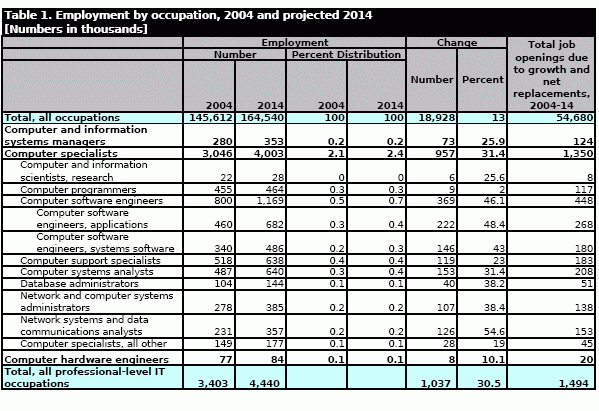THIS IS AN ARCHIVED VERSION OF CRA'S WEBSITE. THIS ARCHIVE IS AVAILABLE TO PROVIDE HISTORICAL CONTENT.
PLEASE VISIT HTTP://WWW.CRA.ORG FOR THE LATEST INFORMATION
| About CRA |
| Membership |
| CRA for Students |
| CRA for Faculty |
| CRA-Women |
| Computing Community Consortium (CCC) |
| Awards |
| Projects |
| Events |
| Jobs |
| Government Affairs |
| Computing Research Policy Blog |
| Publications |
| Data & Resources |
| CRA Bulletin |
| What's New |
| Contact |
| Home |
<< Back to November 2006 CRN Table of Contents
[Published originally in the November 2006 edition of Computing Research News, Vol. 18/No. 5]
BLS Projects Strong Growth in IT Professions
By Jay Vegso
The Bureau of Labor Statistics (BLS) estimates that the professional-level IT workforce will grow at more than twice the rate of the overall workforce between 2004 and 2014, and account for 1 in 19 new jobs. In addition, many of these jobs should pay well.
Every two years, BLS releases workforce projections covering a 10-year period. The definition for the ‘professional IT workforce’ adopted here is that used by the Department of Commerce’s Office of Technology Policy. This adds two occupations to the 10 listed under the “Computer specialists” category (15-0000 through 15-1099) in the BLS tables: Computer and information system managers (11-3021) and Computer hardware engineers (17-2061).
Although each BLS employment projection report covers a slightly different period, it is interesting to see how the forecasts have changed over time. The 2004-2014 projections for the IT workforce are slightly lower, both in terms of numbers and percent growth, than those made in the report for 2002-2012. In the 2002-2012 report, BLS estimated that 1.15 million new jobs would be created—a 35 percent growth rate. Total job openings (new jobs plus openings created to replace workers who leave their jobs) were estimated at 1.6 million. In comparison, the report for 2004-2014 forecasts a lower growth rate in new jobs (30.5 percent), fewer new jobs (1.04 million, or 10 percent lower than for 2002-2012), and fewer total openings (1.49 million, or 7 percent lower than its previous report).
The reduced growth projections made for IT in the 2004-2014 report come on top of the significantly lower expectations BLS gave in its report for 2002-2012. In that report, BLS cut back its projections significantly compared to those predicted in the report for 2000-2010. The estimated number of new jobs was lowered 47 percent from what had been predicted for 2000-2010 (2.16 million versus 1.15 million). As a result, the growth rate fell from 65.8 percent to 35.2 percent. The estimated total openings also were lowered, from 2.49 million to 1.6 million. (See the May 2004 CRN article by John Sargent: http://www.cra.org/CRN/articles/may04/sargent.html).
Even when these declines are factored in, the BLS estimates significant growth for well-paying IT jobs between 2004 and 2014.
In 2004, there were 3.4 million IT professionals out of a total workforce of 145.6 million. The professional IT workforce is projected to add slightly more than a million new jobs between 2004 and 2014, an increase of about 30 percent. In comparison, the total workforce is expected to add 18.9 million jobs.
Six of the 30 occupations that are projected to grow the fastest (i.e., percent gain) between 2004 and 2014 are in the IT profession. Among the 30 fastest-growing occupations, 17 have median salary earnings of $43,605 or above, including all six IT occupations.
Two of the six IT occupations listed as the fastest growing also rank among the 30 that are projected to have the largest numeric growth. Only seven of these 30 have median salary earnings of $43,605 or more, including both IT occupations.

Notes:
The 2004-2014 projections appear in five articles in the November 2005 issue of the Monthly Labor Review, published by the Bureau of Labor Statistics, U.S. Department of Labor. The Review is available online at: www.bls.gov/opub/mlr/welcome.htm
Copyright © 2007 Computing Research Association. All Rights Reserved. Questions? E-mail: webmaster@cra.org.
